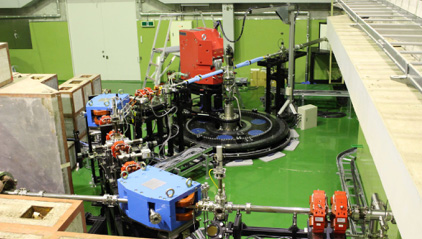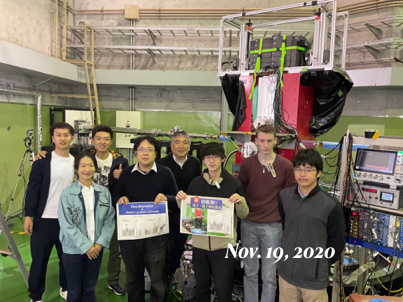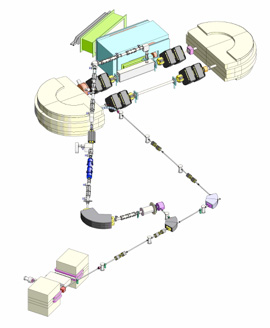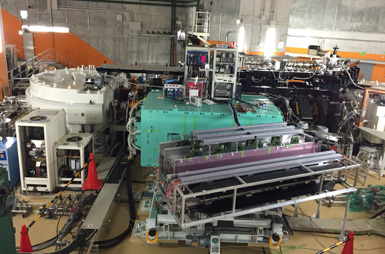(English)On-going researches
Ongoing Nuclear-Physics Researches
Electron Scattering
Electron scattering for subatomic nucleus provides a detailed picture of the interior of the nucleus. We are challenging the following two researches in modern nuclear physics by electron scattering.
(1) Precise measurement of proton size
(2) Research on the size, shape, and internal structure of short-lived unstable exotic nuclei
Electron scattering is the best way to study the size, shape, and other detailed internal structures of nuclei. About half a century ago, the structure of stable nuclei was studied in detail by electron scattering (R. Hofstadter, Nobel Prize in Physics, 1961).
Electron scattering for atomic nuclei is an electron microscope for femto-meter scale objects. (femtometer: fm : 10-15m)
Proton size
Proton-radius determination by electron scattering (ULQ2(Ultra-Low Q2 )project)

Proton, together with the neutron, makes up an atomic nucleus. For many years, its size, shape, and internal structure of the proton have been studied in detail, until 2010 when it was reported that the results of proton radius measurements through electrons and muons, which are considered to be members of the same family in the standard theory of elementary particles, did not match, leading to a situation known as the “proton radius problem.
Such uncertanity of the proton raidus matters in many ways, as
(1) Direct influence to the Rydberg constant, which is a fundamental physical constant.
(2) Charge density distribution of nuclei composed of protons and neutrons

The proton radius, which has been measured mainly by high-energy electron scattering, has been pointed out to have a possibility of large analytical model dependence. We are aiming at the most reliable determination of the proton radius by electron and proton elastic scattering experiments at the lowest energy in history (Ee = 20 – 60 MeV) using the 60 MeV electron accelerator at our center, which is impossible with high-energy electron scattering.
A new electron beam transport system and a high-resolution electromagnetic spectrometer for the detection of elastically scattered electrons have been constructed to carry out this research; commissioning started at the end of 2020 and the performance has been confirmed to be as designed. Some experimental equipment is scheduled to be constructed and installed during FY2021, and preparations are underway for full-scale measurements starting in FY2022.
This research is supported by the following two Grants-in-Aid for Scientific Research.
1)科研費基盤研究 (S) 2016-2020年 研究代表者 須田利美
2)「科研費基盤研究 (S) 2020-2024年 研究代表者 須田利美
Structure studies of exotic short-lived nuclei by electron scattering (SCRIT Project)

Electron scattering is a mainstay of nuclear structure research, but it has been considered impossible to study unstable nuclei, which are difficult to produce and decay in a short period of time, by electron scattering due to their difficulty. We have invented an experimental technique called the SCRIT method (Self Confining RI Target) to break through this barrier, and have constructed the world’s first electron scattering facility dedicated to exotic nuclei at RIKEN.
This method uses a high-energy electron storage ring. The electrostatic potential created by the circling electron beam traps the nuclear ions to be studied on the electron beam.
The capture of residual gas in the accelerator, which is ionized by the electron beam, by the circling electrons is well known as the ion capture situation. This ion capture has been treated as a problem child because the captured ions scatter the electrons and cause the phenomena of the orbiting electron beam and the instability of the accelerator.
Our idea of SCRIT is to take advantage of this phenomenon by having the (unstable) nuclei under study captured by the electron beam itself, automatically causing electron scattering. This way, the ions cannot escape from the electron beam and stay on the beam, allowing us to perform experiments with very small numbers of ions.

(Window-frame Spectrometer for Electron Scattering)
This research is being conducted at the RI Beam Factory (RIBF) of RIKEN, which is capable of producing short-lived unstable nuclei with the world’s highest intensity. The charge density distribution of short-lived unstable nuclei is determined by observing elastically scattered electrons. Our research group at Tohoku University has constructed and is operating a large electromagnetic spectrometer to identify and observe elastically scattered electrons.
科研費基盤研究 (S) 2010-2015年 研究代表者 須田利美
